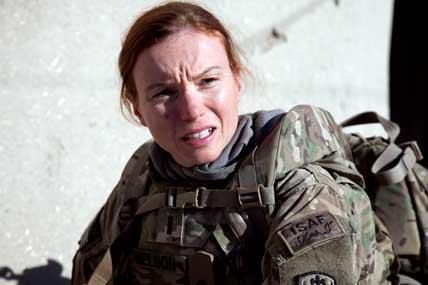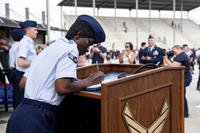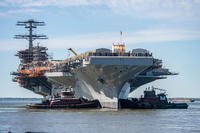The U.S. military's leadership lifted the official ban on women serving in combat roles Thursday. Defense Secretary Leon Panetta said removing gender barriers within the U.S. military will improve the fighting force as a whole.
"It's clear to all of us that women are contributing in unprecedented ways to the military's mission of defending the nation," Panetta said. "Female servicemembers have faced the reality of combat, proven their willingness to fight and, yes, to die to defend their fellow Americans."
Panetta and Army Gen. Martin Dempsey, the chairman of the Joint Chiefs of Staff, said lifting the ban would open up about 237,000 military jobs to women. About 53,000 positions are closed to women by units, such as Brigade Combat Teams in the Army, and another 184,000 by Military Occupational Specialty (MOS), such as Special Forces or tank crews.
"We are eliminating the direct ground combat exclusion rule" that barred women from front-line infantry, armor, artillery units and Special Operations, Panetta said. In the future, "if members of the military meet the qualifications for the job – not reduced qualifications – then they should have the right to serve" in whatever MOS they choose, Panetta said.
Panetta and Dempsey ordered the service chiefs to report back to them by May 15 on how they intend to implement the new rules, but Dempsey said he expected women to begin serving this year in previously barred specialties. The services will have until January 2016 to decide whether to ask for exceptions in certain MOS fields to the elimination of the ban on women in combat roles.
Lifting the ban recognizes the realities of service in the modern military after more the 10 years of war in 360-degree combat zones where insurgent attacks come from any direction and front lines are non-existent, Dempsey said.
"The more we can treat people equally, the more likely they are to treat each other equally" and improve readiness, Dempsey said.
Women make up approximately 15 percent, or nearly 202,400, of the U.S. military's 1.4 million active duty personnel. More than 280,000 women have served in Iraq and Afghanistan. At least 152 military women have been killed and more than 300 have earned Purple Heats for wounds in combat.
"We're way beyond that" already, Dempsey said of the current ban on women in ground combat. It ignores the daily performance of women as military police, medics and as part of "Female Engagement Teams" on patrol in Iraq and Afghanistan.
Dempsey said he "realized something had changed" when he jumped into a Humvee in Iraq as a division commander, slapped the leg of the turret gunner and asked: "Who are you?" The soldier replied "I'm Amanda," Dempsey said.
The standard on women has shifted from why they shouldn't to why they should serve in a particular specialty, Dempsey said.
Panetta acted on his own in removing the ban on women in combat roles under his statutory authority, and that of President Obama as commander-in-chief. His action did not require approval from Congress.
But Panetta and his nominated successor, former Sen. Chuck Hagel (R-Neb.), will be required to give "notification" to Congress as each MOS is opened up to women, DOD officials said. A senior DOD official said that Panetta informed Hagel on Wednesday of his decision and that Hagel gave his full support.
Lifting the ban on women in combat was unlike the elimination of the "Don't Ask, Don't Tell" rule against gays serving openly in the military. Congress enacted a bill in 2010 to repeal DADT pending certification from Obama, the secretary of defense and the chairman of the Joint Chiefs of Staff that repeal would not harm military readiness.
Certification came in September 2011, and the military service chiefs have since attested that there have been few problems with gays serving openly.
Dempsey also said he expected that lifting the ban would eventually curb the instances of sexual harassment and attacks against women that have plagued the military in recent years.
Having "part of the population designated as warriors and one as something else," Dempsey said has "in some way led to that environment. I believe it's because we've had separate classes of personnel."
Last February, Panetta opened more than 14,000 additional positions to women by allowing them to be assigned to select positions in ground combat units at the battalion level.
Earlier, DOD officials and representatives of the military services, speaking on background at the Pentagon, said that they had no estimate on the possible costs of lifting the ban.
The Navy has recently removed the ban for women to serve on submarines. Navy representative said that allowing women to apply for more positions on submarines would likely require minor overhauls provide for separate quarters and showers. Women are allowed to qualify for positions on ballistic submarines but are barred from the smaller attack submarines, the Navy official said.
"Three years ago we announced a policy change allowing women to serve in guided-missile attack (SSGNs) and ballistic missile submarines (SSBNs) and this is a planned continuation of that effort," Navy Secretary Ray Mabus said in a statement.
The service chiefs have been working over the past year to make sure that the rank and file will go along with changes, the officials said. Gen. James Amos, the Marine Commandant, personally met with 19 battalion commanders, the Marine representative said.
"I think that got their attention," he said.
In a stament on the change, Amos said "it's simply the right thing to do." Army Chief of Staff Gen. Ray Odierno said he welcomed the new policy.
"Fundamentally, this is about managing talent and posturing the Army and individual soldiers for success," Odierno said in a statement.
The objective was "to open up positions to men and women with a gender-neutral standard" which may require an adjustment – but not a lowering – of physical qualifications, a senior DOD official said.
The official cited the example of the position of tank loader. Whether it's a man or a woman, the applicant will have to show the upper body strength to wrestle 50-pound shells into the breech in cramped quarters, the official said.
"The Joint Chiefs share common cause on the need to start doing this now and to doing this right. We are committed to a purposeful and principled approach," Dempsey said.




























